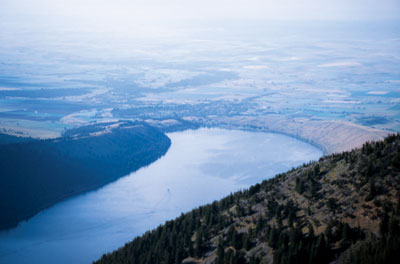What caused the Ice Age?

Secular scientists have challenged creation scientists to explain the Ice Age. Also, they claim that there were numerous ice ages, possibly up to fifty, at intervals of 100,000 or 40,000 years over the past 2.6 million years.1 Bible believers need to respond to this challenge by appealing to 1 Thessalonians 5:21: “Examine everything carefully; hold fast that which is good” (NASB). As we maintain confidence in God’s word we need to carefully examine the observed data and be wary of how naturalism (‘there is no God’) has influenced its interpretations.
First we must establish whether there ever was an ice age. This is easy to do since there are hundreds of surface features in the mid and high latitudes similar to those around existing glaciers. They include terminal and lateral moraines (ridges of rock debris), scratched boulders, and scratched bedrock (figures 1 and 2). It is not possible for a moraine to be formed by liquid water.
Ice Age features are found on over 30% of the world’s land mass, indicating past coverage by ice sheets or glaciers. Today only 10% is glaciated, mainly Antarctica and Greenland. There was only one (see “How many ice ages”) and observations indicate that it was recent. Sharp crested moraines (figure 1) and scratched bedrock indicate youth. If the rocks were old, weathering should have rounded the moraines and erased the scratches in figure 2.
The Ice Age is a major challenge to secular science
Often a challenge to creation scientists is also a challenge for secular scientists. In regard to the Ice Age, books and college professors sometimes falsely state it is easy for an Ice Age to develop: “It takes relatively little change to plunge us back into a situation where ice could start accumulating again on the fells [hills] and we are into a rapid downward spiral.”2

But when we study the requirements for an ice age we find a different picture. Currently in most areas where there was once an ice sheet the winters are cold enough, but don’t have even close to enough snowfall. Springs, summers, and autumns would need to become significantly cooler than now to maintain the ice. Most challenging of all, these unusual conditions would need to last hundreds of years.
When we calculate how much spring and summer cooling would be needed, the picture becomes clearer. The temperatures would have to fall to below freezing on the average to maintain snow cover until the end of summer. Sunshine is the main cause of melting snow cover, even more effective than warmer temperatures. Summer sunshine at mid and high latitudes is intense. Using the net melting of snow and ice at low altitudes of the Antarctica Ice Sheet3 as an example, the average temperature has to fall to about -7°C (20°F) for any winter and spring snow to last through the summer until the late autumn. This represents a cooling of about 19 Celsius degrees (34 Fahrenheit degrees) for the high latitudes of Scandinavia and Canada and about 28 Celsius degrees (50 Fahrenheit degrees) for the mid latitudes, such as the northern United States and along the southern edge of the ice sheet that developed in Europe and Asia.
Secular scientists propose that present processes or slight changes in the earth’s orbital geometry could cause such cooling, but these have too small an effect. Even if cooler temperatures could be generated this way, the air would then become about 60% drier. This would definitely interfere with snow development. So, there is a major problem in accounting for the massive amount of snow required for an ice age. And to make matters worse, even if by chance this climate change lasted a year, it would not fulfill the requirement of the climate change lasting for hundreds of years.
This is why the Ice Age is a major challenge for secular scientists. There are over 60 ideas (theories) on the origin of the Ice Age. That is why David Alt, professor of geology at the University of Montana, stated: “Although theories abound, no one really knows what causes ice ages.”4
Can the Ice Age be explained within the biblical worldview?
Secular scientists really can’t explain how an Ice Age happened, but can creation scientists? Yes, but first it needs to be placed within biblical earth history. The glacial features lie on top of sedimentary rock. This is a good indication that the Ice Age happened after the Flood. The conditions after the Flood were unique. Investigating them can help us find the answer.5

The Flood was a very catastrophic global event that included massive volcanism. So, after the Flood, numerous small volcanic particles were trapped high up in the atmosphere. These particles cooled the earth by reflecting sunlight back to space. But the volcanic particles would slowly settle out over several years. It is well accepted from the physical evidence that during the Ice Age there were many more volcanic eruptions than we have today. These would continually replenish the upper atmosphere with fine particles, probably stretching the cooling to several hundred years. So, the cooler summer requirement for the Ice Age is fulfilled. What about the second; where does the moisture for the required snowfall come from?
The Flood water was heated through volcanism (hot lava), and hot water was added by the “fountains of the great deep”. The flood was a dynamic event, so after the Flood, the oceans would be mostly warm—from pole to pole and top to bottom. As a result there would be no sea ice on any of the oceans.
Warm water evaporates more quickly than cold; the warmer the water the quicker the evaporation. With the mid and high latitude oceans being much warmer than they are today, there would be many times more evaporation. As the moisture met the cooler continents it would trigger gigantic storms. This snow would dump along and poleward of the jet stream and storm tracks. It would eventually turn into ice primarily by summer melting and refreezing. This fulfills the second criterion. Figure 3 shows all these events.
How long?
The third criterion, time, would be fulfilled, because in time evaporation would cool the oceans. And eventually volcanism would settle down. A cooler ocean would generate less moisture and less snow so the Ice Age would gradually wind down. Less volcanism would provide more sunshine, melting the ice sheets. Calculating the rate of cooling of the ocean after the Flood can give a rough estimate of the length of the Ice Age.
Based on the cooling of the oceans, the Ice Age could reach glacial maximum in about 500 years. It would have an average depth of about 700 m (2,300 ft) in the Northern Hemisphere and about 1,200 m (3,940 ft) over Antarctica, where most of the ice collected in the Southern Hemisphere.
Using the melting equation, we can figure out the ice sheet melting time. At first the ice would melt slowly then faster with giant lakes occurring at the edge of the ice. Some of these lakes broke causing gigantic floods, such as the Lake Missoula flood in the northwest United States.6 It would take only about 70 years to melt the ice sheets along the edge and about 200 years in interior Canada and Scandinavia. That is a total time of approximately 700 years for the Ice Age. We do not need a hundred thousand years for an ice age.
How many ice ages?

The secular idea of multiple ice ages comes from the belief that the earth’s orbit changes slightly over millions of years but is cyclical, and that these cycles cause many ice ages. To buttress this idea, scientists sample the bottom of the oceans by dropping a tube into bottom sediments. They then analyze several variables in the sediment tube sample. The variables wiggle back and forth around an average. Since there are dozens of wiggles secular scientists simply assume that each wiggle is an ice age.
On land, most areas have evidence consistent with only one ice age. At the edge of the ice sheets, the glacial debris can be complicated, and it is here that they try to claim many ice ages. Yet, it is well known that the edge of an ice sheet advances, retreats, and surges rapidly forward creating complicated glacial sediments. It was admitted by five secular scientists that multiple ice ages are really an assumption.7 Instead of three or four ice ages in Alberta, Canada, these scientists concluded that there was only one.
We can solve other challenges
Secular scientists have often challenged creationists to explain the Ice Age. This was met by accepting the biblical history and examining the data. This is an example of how we can solve other challenges to the Bible. We need to be seekers of truth (1 Thess. 5:21). Often we find the challenges we face are also challenges to secular scientists, although they often hide their difficulties. Having a correct understanding of a unique global Flood can solve many challenges presented by secular scientists with a commitment to the evolutionary/long-age paradigm. We need to be as committed to biblical earth history.
References and notes
- Walker, M. and Lowe, J., Quaternary science 2007: a 50-year retrospective, Journal of the Geological Society, London 164(6):1,073–1,092, November 2007. Return to text
- Smith, A., The Ice Age in the Lake District: The Landscapes of Cumbria No. 3, Riggs Side Publications, Keswick, Cumbria, England, p. 7, 2008. Return to text
- Pickard, J., Comments on “Wastage of the Klutlan ice-cored moraines, Yukon Territory, Canada” by Driscoll (1980), Quaternary Research 22(2):767–782, 1984. Return to text
- Alt, D., Glacial Lake Missoula and Its Humungous Floods, Mountain Press, Missoula, Montana, p. 180, 2001. Return to text
- Oard, M.J., Frozen in Time: Woolly Mammoths, the Ice Age, and the Biblical Key to Their Secrets, Master Books, Green Forest, Arkansas, 2004; Oard, M., The Ice Age: Only the Bible Can Explain It! CMI DVD, 2011; Oard, M.J., The Great Ice Age, Awesome Science Media DVD, 2013. Return to text
- Oard, M.J., The Missoula Flood Controversy and the Genesis Flood, Creation Research Society Books, Chino Valley, Arizona, 2004. See also summary article in Creation 36(2):43–46, 2014. Return to text
- Young, R.R., Burns, J.A., Smith, D.G., Arnold, L.D, and Rains, R.B., A single, late Wisconsin, Laurentide glaciation, Edmonton area and southwestern Alberta, Geology 22:683–686, 1994. Return to text





Readers’ comments
Comments are automatically closed 14 days after publication.